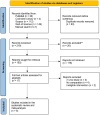The effects of omega-3 polyunsaturated fatty acids on muscle and whole-body protein synthesis: a systematic review and meta-analysis
- PMID: 38777807
- PMCID: PMC11723138
- DOI: 10.1093/nutrit/nuae055
The effects of omega-3 polyunsaturated fatty acids on muscle and whole-body protein synthesis: a systematic review and meta-analysis
Abstract
Context: Sarcopenia describes the age-related decline in skeletal muscle mass and strength that is driven, at least in part, by an imbalance between rates of muscle protein synthesis (MPS) and muscle protein breakdown. An expanding body of literature has examined the effect of omega-3 polyunsaturated fatty acid (n-3 PUFA) ingestion on MPS rates in older adults, with mixed findings.
Objective: The aim of this systematic review and meta-analysis was to investigate the effectiveness of n-3 PUFA ingestion in stimulating rates of MPS and whole-body protein synthesis in healthy adults and clinical populations.
Data sources: Searches were conducted of the PubMed, Web of Science, Cochrane Library, and Scopus databases from inception until December 2022 for articles on randomized controlled trials comparing the effect of n-3 PUFA ingestion vs a control or placebo on rates of MPS and whole-body protein synthesis. The search yielded 302 studies, of which 8 were eligible for inclusion.
Data extraction: The random effects inverse-variance model was used and standardized mean differences (SMDs) with 95%CIs were calculated to assess the pooled effect. Risk of bias was assessed by the Cochrane Risk-of-Bias 2 tool.
Data analysis: The main analysis indicated no effect of n-3 PUFA supplementation on MPS rates (k = 6; SMD: 0.03; 95%CI, -0.35 to 0.40; I2 = 30%; P = .89). Subgroup analysis based on age, n-3 PUFA dose, duration of supplementation, and method used to measure fractional synthetic rate also revealed no effect of n-3 PUFA ingestion on MPS. In contrast, the main analysis demonstrated an effect of n-3 PUFA ingestion on increasing whole-body protein synthesis rates (k = 3; SMD: 0.51; 95%CI, 0.12-0.90; I2 = 0%; P = .01).
Conclusions: n-3 PUFA ingestion augments the stimulation of whole-body protein synthesis rates in healthy adults and clinical populations.
Systematic review registration: PROSPERO registration no. 42022366986.
Keywords: fish oil; fractional synthetic rate; muscle protein synthesis; omega-3; sarcopenia.
© The Author(s) 2024. Published by Oxford University Press on behalf of the International Life Sciences Institute.
Conflict of interest statement
None declared.
Figures




References
-
- Landi F, Liperoti R, Russo A, et al. Sarcopenia as a risk factor for falls in elderly individuals: results from the ilSIRENTE study. Clin Nutr. 2012;31(5):652-658. - PubMed
Publication types
MeSH terms
Substances
LinkOut - more resources
Full Text Sources

